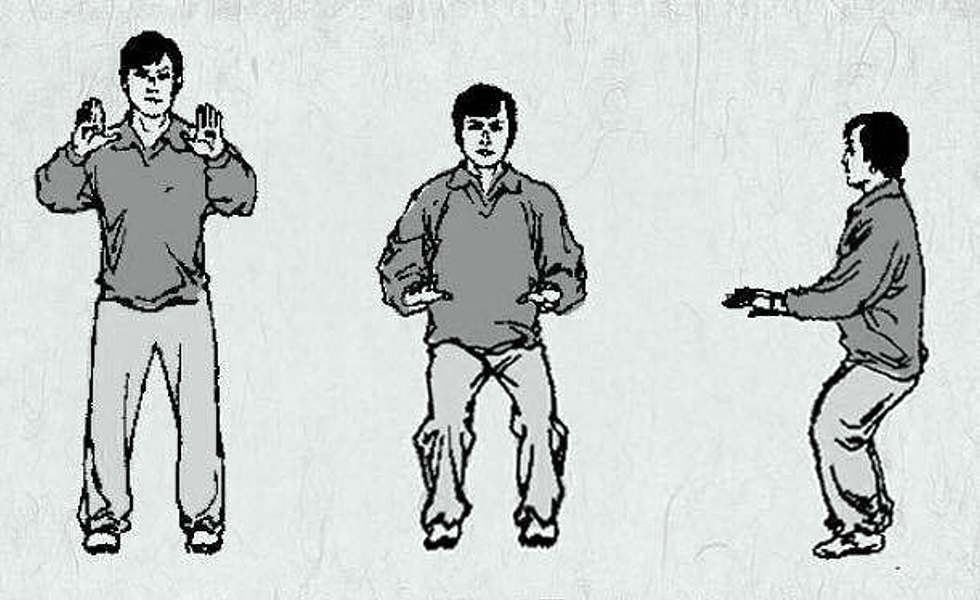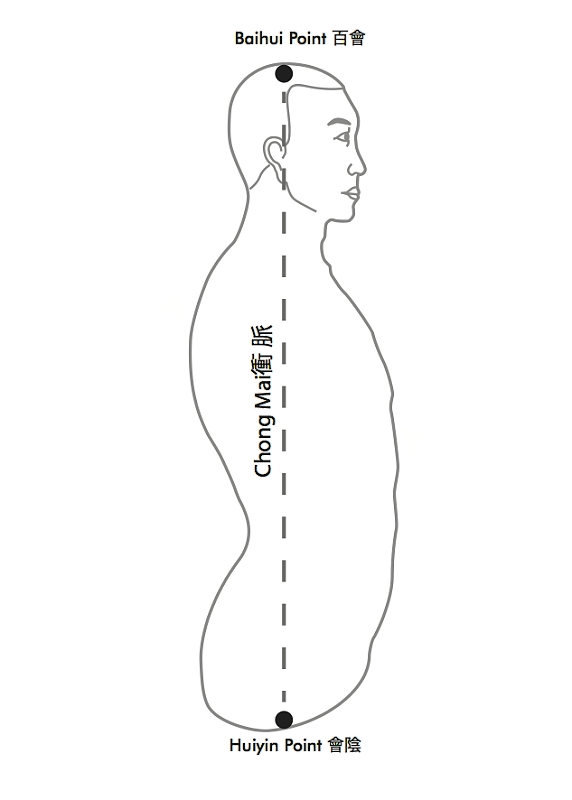„Tři středy“ v tchaj-ťi čchüan
For the English version of the article called „Taijiquan 3 centres“ see below.
S tudenti tchaj-ťi čchüan by měli mít jasno v základních pojmech, funkcích a účincích „tří středů“ těla, tj. středové linie těla, těžiště a středové osy.
Středová linie těla představuje čáru, která symetricky rozděluje tělo na levou a pravou stranu, od čela (horní tan-tchien), přes nos, střed hrudníku (akupunkturní bod tan čung / dan zhong nazývaný střed hrudi nebo horní moře čchi) až k hrázi. Během cvičení fungují ruce jako dvojí dveře, každá ruka hlídá jednu stranu těla a nemůže přecházet přes čáru vymezující střed. Jakmile zápěstí přesáhne tuto středovou čáru, předloktí přichází o svůj opěrný bod a ruka ztrácí sílu.
 Pro příležitostné cvičence není možná tato linie tak důležitá, ale pro bojové dovednosti má velký význam. Často citované „hlídání středu“ odkazuje právě na tuto obrannou středovou linii.
Pro příležitostné cvičence není možná tato linie tak důležitá, ale pro bojové dovednosti má velký význam. Často citované „hlídání středu“ odkazuje právě na tuto obrannou středovou linii.
Setrvání těla v těžišti (tj. správné vyvážení středu) je udržováno propojením bodu paj-chuej (bai hui) na vrcholu hlavy a bodů jung-čchüan (yongquan) na chodidlech. Toto nastavení je viditelnější ze strany, prochází od bodu paj-chuej, přes ucho, rameno, dolu po noze do bodu jung-čchüan.
Abyste měli dobrý postoj a stabilitu, zůstávejte (zasednutí) v těžišti. Ke špatnému nastavení těla dochází zpravidla díky neschopnosti uvolnit a aktivovat kchua (kua), tj. oblast třísel a kyčlí, čímž se kolena dostávají příliš dopředu a ven.
 Středová osa je linie spojující body paj-chuej (bai hui) a chuej-jin (hui yin) a jedná se o vertikální osu těla. Horní část těla se otáčí doprava nebo doleva pomocí otáčení kchua kolem středové osy a řídí pohyb obou rukou.
Středová osa je linie spojující body paj-chuej (bai hui) a chuej-jin (hui yin) a jedná se o vertikální osu těla. Horní část těla se otáčí doprava nebo doleva pomocí otáčení kchua kolem středové osy a řídí pohyb obou rukou.
Vertikální osu je nutné udržovat rovnou, což je splněno při dodržení základních požadavků, které většina studentů zná: máte uvolněný krk, vzpřímenou hlavu, uvolněná ramena a lokty, zakulacený hrudník a současně rovná (ne však strnulá) záda, uvolněná kchua a zakulacený rozkrok (tj. otevřené kyčle).
Často dochází k zaměňování středové osy a těžiště těla. Pokud však středová osa převezme funkci těžiště, tělo ztuhne jako tyč místo toho, aby fungovalo jako pružina. Se středovou osou těla nelze zaměňovat ani páteř.
Zdroj: Taijiquan 3 centres, Chinese Whispers – Davidine SV Sim
Překlad: Alena Koutecká
Taijiquan three centres
 Practitioners should be clear about the basic concepts, functions and effects of the “three centres” of the body, i.e., the centre line of the body, the centre of gravity, and the central axis.
Practitioners should be clear about the basic concepts, functions and effects of the “three centres” of the body, i.e., the centre line of the body, the centre of gravity, and the central axis.
The centre line of the body acts as a symmetry line that distinguishes between the left and right side of the body, from the forehead (Upper Dan Tian), the nose, centre of the chest (Dan Zhong), to the perineum. During practice, the hands are like two doors, each in charge of one side of the body and cannot cross the middle line. As soon as the wrist crosses the midline, the forearm loses its fulcrum and the hand loses its strength. This line may not be very important to the casual practitioners but it has a great significance in fighting skill. The often-said “guarding the centre” refers to this defensive middle line.
 The centre of gravity is maintained through the alignment of the Bai Hui (at the top of the head) and the Yong Quan (at the bottom of the feet). The alignment is more obvious viewed from the side, from the Bai Hui, the ear, shoulder, down the leg into the Yong Quan. Maintain the centre of gravity for good posture and stability. Misalignment is usually through the inability to loosen and activate the kua, thus pushing the knees forwards and outwards.
The centre of gravity is maintained through the alignment of the Bai Hui (at the top of the head) and the Yong Quan (at the bottom of the feet). The alignment is more obvious viewed from the side, from the Bai Hui, the ear, shoulder, down the leg into the Yong Quan. Maintain the centre of gravity for good posture and stability. Misalignment is usually through the inability to loosen and activate the kua, thus pushing the knees forwards and outwards.
The central axis is the line linking Bai Hui to Hui Yin, and is the vertical axis of the body. The upper body turns left or right with the help of kua rotation through the vertical axis, driving the movement of both hands. The vertical axis must be kept straight, made possible by adhering to the fundamental requirements that most practitioners are familiar with: relax the neck and keep the head up; loosen the shoulders and sink the elbows; contain the chest and settle the back; loosen the kua and round the crotch.
There are often confusions between the central axis and the centre of gravity. If the central axis takes the function of the centre of gravity the body will become a stick rather than a spring. The spine is also not to be mistaken as the central axis.
Source: Taijiquan 3 centres, Chinese Whispers, Davidine SV Sim



